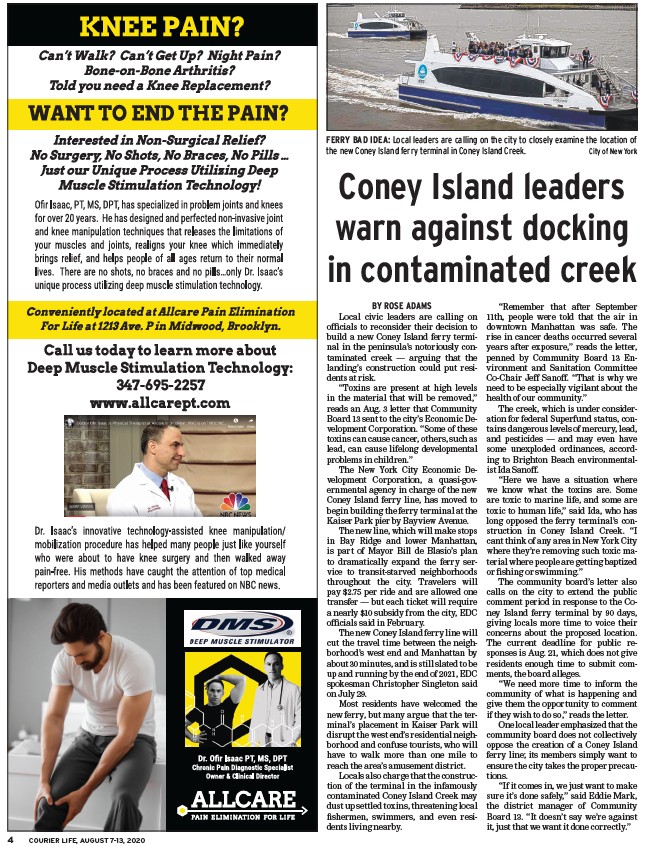
COURIER L 4 IFE, AUGUST 7-13, 2020
FERRY BAD IDEA: Local leaders are calling on the city to closely examine the location of
the new Coney Island ferry terminal in Coney Island Creek. City of New York
Coney Island leaders
warn against docking
in contaminated creek
BY ROSE ADAMS
Local civic leaders are calling on
offi cials to reconsider their decision to
build a new Coney Island ferry terminal
in the peninsula’s notoriously contaminated
creek — arguing that the
landing’s construction could put residents
at risk.
“Toxins are present at high levels
in the material that will be removed,”
reads an Aug. 3 letter that Community
Board 13 sent to the city’s Economic Development
Corporation. “Some of these
toxins can cause cancer, others, such as
lead, can cause lifelong developmental
problems in children.”
The New York City Economic Development
Corporation, a quasi-governmental
agency in charge of the new
Coney Island ferry line, has moved to
begin building the ferry terminal at the
Kaiser Park pier by Bayview Avenue.
The new line, which will make stops
in Bay Ridge and lower Manhattan,
is part of Mayor Bill de Blasio’s plan
to dramatically expand the ferry service
to transit-starved neighborhoods
throughout the city. Travelers will
pay $2.75 per ride and are allowed one
transfer — but each ticket will require
a nearly $10 subsidy from the city, EDC
offi cials said in February.
The new Coney Island ferry line will
cut the travel time between the neighborhood’s
west end and Manhattan by
about 30 minutes, and is still slated to be
up and running by the end of 2021, EDC
spokesman Christopher Singleton said
on July 29.
Most residents have welcomed the
new ferry, but many argue that the terminal’s
placement in Kaiser Park will
disrupt the west end’s residential neighborhood
and confuse tourists, who will
have to walk more than one mile to
reach the area’s amusement district.
Locals also charge that the construction
of the terminal in the infamously
contaminated Coney Island Creek may
dust up settled toxins, threatening local
fi shermen, swimmers, and even residents
living nearby.
“Remember that after September
11th, people were told that the air in
downtown Manhattan was safe. The
rise in cancer deaths occurred several
years after exposure,” reads the letter,
penned by Community Board 13 Environment
and Sanitation Committee
Co-Chair Jeff Sanoff. “That is why we
need to be especially vigilant about the
health of our community.”
The creek, which is under consideration
for federal Superfund status, contains
dangerous levels of mercury, lead,
and pesticides — and may even have
some unexploded ordinances, according
to Brighton Beach environmentalist
Ida Sanoff.
“Here we have a situation where
we know what the toxins are. Some
are toxic to marine life, and some are
toxic to human life,” said Ida, who has
long opposed the ferry terminal’s construction
in Coney Island Creek. “I
cant think of any area in New York City
where they’re removing such toxic material
where people are getting baptized
or fi shing or swimming.”
The community board’s letter also
calls on the city to extend the public
comment period in response to the Coney
Island ferry terminal by 90 days,
giving locals more time to voice their
concerns about the proposed location.
The current deadline for public responses
is Aug. 21, which does not give
residents enough time to submit comments,
the board alleges.
“We need more time to inform the
community of what is happening and
give them the opportunity to comment
if they wish to do so,” reads the letter.
One local leader emphasized that the
community board does not collectively
oppose the creation of a Coney Island
ferry line; its members simply want to
ensure the city takes the proper precautions.
“If it comes in, we just want to make
sure it’s done safely,” said Eddie Mark,
the district manager of Community
Board 13. “It doesn’t say we’re against
it, just that we want it done correctly.”